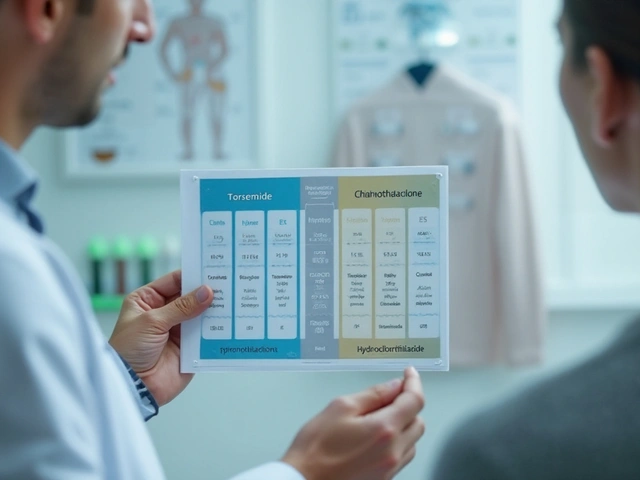
Alzheimer's Medication Comparison Tool
Select a medication below to compare key characteristics side-by-side:
Donepezil
(Aricept)
Cholinesterase Inhibitor
Rivastigmine
(Exelon)
Cholinesterase Inhibitor
Galantamine
(Razadyne)
Cholinesterase Inhibitor
Memantine
(Namenda)
NMDA Antagonist
Medication Comparison
Select a medication above to view detailed comparison information.
Quick Decision Guide
Start Here
- Mild-to-moderate Alzheimer’s: Start with Donepezil, Rivastigmine, or Galantamine
- Severe symptoms: Add Memantine to existing cholinesterase inhibitor
- GI issues: Try Rivastigmine patch instead of oral tablets
Considerations
- Dosing frequency: Donepezil once daily vs Galantamine twice daily
- Side effects: Nausea common with all cholinesterase inhibitors
- Cost: Generic versions offer best value
Key Takeaways
- Donepezil (Aricept) is the most prescribed cholinesterase inhibitor for mild‑to‑moderate Alzheimer’s disease.
- Rivastigmine and galantamine offer similar benefits but differ in dosing frequency and side‑effect profiles.
- Memantine works via a completely different mechanism (NMDA antagonism) and is typically added for moderate‑to‑severe disease.
- Cost, tolerability, and individual health conditions often decide which drug is best.
- Regular monitoring by a caregiver or clinician can prevent many avoidable problems.
When a loved one is diagnosed with Alzheimer’s disease, the first question is usually “which medication should we start with?” Donepezil (brand name Aricept) is the go‑to drug in many countries, but it isn’t the only option. This Donepezil comparison breaks down the four most common Alzheimer’s medicines, showing where they overlap, where they differ, and how to pick the right one for your situation.
What is Donepezil (Aricept) and How Does It Work?
Donepezil is a reversible cholinesterase inhibitor that boosts the level of acetylcholine, a brain chemical important for memory and learning. FDA approval came in 1996, and since then it has become the most prescribed drug for mild‑to‑moderate Alzheimer’s disease.
Typical dosing starts at 5mg once daily, usually taken at bedtime. After four weeks, the dose can be increased to 10mg, and for patients who tolerate it well, a 23mg daily tablet is an option for those already on 10mg.
Clinical trials show an average improvement of 2‑3 points on the Mini‑Mental State Examination (MMSE) over six months compared with placebo. While that sounds modest, it often translates into a noticeable delay in daily‑living skill loss.
Common side effects include nausea, diarrhea, insomnia, and muscle cramps. Most side effects are mild and improve with dose titration. Serious concerns such as heart‑block or bradycardia are rare but require monitoring, especially in patients with pre‑existing cardiac conditions.
Cost varies by market. In the United States, the generic version can range from $30 to $70 per month, while brand‑name Aricept can exceed $300 per month without insurance.
Alternative #1 - Rivastigmine (Exelon)
Rivastigmine is another cholinesterase inhibitor that also inhibits butyryl‑cholinesterase, giving it a slightly broader enzyme target than donepezil.
It is available as an oral capsule (1.5mg twice daily) and as a transdermal patch (4.6mg/24h, up‑titrated to 9.5mg/24h). The patch is popular for patients who have gastrointestinal upset from the pills.
Effectiveness is comparable to donepezil in mild‑to‑moderate disease, though some studies suggest the patch may provide steadier plasma levels and fewer GI side effects.
Side effects include skin irritation (patch), nausea, vomiting, and loss of appetite. The patch can cause contact dermatitis in about 5% of users.
Pricing: generic oral capsules cost $25‑$45 per month, while the patch ranges from $70‑$120 depending on dose.
Alternative #2 - Galantamine (Razadyne)
Galantamine is a third‑generation cholinesterase inhibitor that also acts as an allosteric modulator of nicotinic receptors, potentially enhancing neurotransmission beyond acetylcholine alone.
The usual oral regimen starts at 4mg twice daily, titrated up to 8mg twice daily after four weeks, and then possibly to 12mg twice daily.
Clinical data show roughly the same cognitive benefit as donepezil, with a slightly higher incidence of dizziness and visual disturbances.
Common adverse events are nausea, weight loss, and vivid dreams. Because it is taken twice daily, adherence can be more challenging for some patients.
In the U.S., generic galantamine costs about $35‑$60 per month.
Alternative #3 - Memantine (Namenda)
Memantine belongs to a different drug class: it is an NMDA (N‑methyl‑D‑aspartate) receptor antagonist. Instead of increasing acetylcholine, it protects neurons from excitotoxicity caused by excessive glutamate.
It is approved for moderate‑to‑severe Alzheimer’s disease and is often combined with a cholinesterase inhibitor.
Starting dose is 5mg once daily, increased weekly by 5mg until reaching 20mg daily (usually split into two doses).
Memantine has a more favorable GI profile but can cause dizziness, headache, and constipation. Its cognitive benefit is usually modest on its own, but the combination with a cholinesterase inhibitor often yields the best outcomes.
Generic memantine costs $20‑$40 per month, making it one of the most affordable options.
Head‑to‑Head Comparison
| Drug | Mechanism | Typical Dose | Common Side Effects | FDA Approval Year | Approx. Monthly Cost (US) |
|---|---|---|---|---|---|
| Donepezil (Aricept) | Reversible cholinesterase inhibitor | 5mg → 10mg → 23mg daily | Nausea, insomnia, muscle cramps | 1996 | $30‑$70 (generic) |
| Rivastigmine (Exelon) | Reversible cholinesterase & butyryl‑cholinesterase inhibitor | 1.5mg BID oral or 4.6‑9.5mg/24h patch | Skin irritation (patch), GI upset | 2000 | $25‑$120 (depending on form) |
| Galantamine (Razadyne) | Cholinesterase inhibitor + nicotinic receptor modulator | 4‑12mg BID | Dizziness, vivid dreams, nausea | 2001 | $35‑$60 |
| Memantine (Namenda) | NMDA receptor antagonist | 5‑20mg daily (usually split) | Dizziness, constipation, headache | 2003 | $20‑$40 |

How to Choose the Right Medication
There is no one‑size‑fits‑all answer. Below are the main factors that usually guide the decision.
- Disease stage: For mild‑to‑moderate Alzheimer’s, cholinesterase inhibitors (donepezil, rivastigmine, galantamine) are first‑line. Memantine is added when symptoms progress to moderate‑severe.
- Side‑effect tolerance: If a patient experiences persistent nausea with donepezil, switching to the rivastigmine patch can reduce GI complaints.
- Dosing convenience: Once‑daily donepezil or the once‑weekly rivastigmine patch may improve adherence compared with twice‑daily galantamine.
- Cost and insurance coverage: Generic memantine and donepezil are often the cheapest. Check formulary tiers before committing.
- Co‑existing health issues: Patients with cardiac conduction problems need careful monitoring on cholinesterase inhibitors. Those with severe kidney impairment may need dose adjustments for memantine.
In practice, many clinicians start with donepezil because of its simple dosing and solid evidence base. If the patient can’t tolerate it after a trial of 4‑6 weeks, they try rivastigmine or galantamine. When the disease advances, memantine gets added to the regimen.
Practical Tips for Patients and Caregivers
- Start low, go slow: Begin at the lowest dose and increase gradually. This reduces the chance of GI upset.
- Track symptoms: Keep a daily log of cognition changes, mood, and side effects. Share this with the prescribing clinician.
- Stay consistent: Take the medication at the same time each day. Use pill organizers or reminder apps.
- Watch for drug interactions: Anticholinergic meds (e.g., certain antihistamines) can blunt the effect of cholinesterase inhibitors.
- Regular follow‑ups: Schedule appointments every 3‑6 months to reassess efficacy and adjust the regimen.
For caregivers, monitoring hydration, nutrition, and sleep quality can make a big difference in how well the medication works. Simple measures like a balanced diet and a consistent bedtime routine often improve tolerance.
Frequently Asked Questions
Can I take two cholinesterase inhibitors together?
No. Combining them does not increase benefit and raises the risk of side effects. The standard practice is to use one cholinesterase inhibitor at a time, and add memantine later if needed.
How long does it take to see an effect?
Most patients notice a modest stabilization of symptoms within 4‑6 weeks of reaching the target dose. Full benefits may become clearer after 3‑6 months.
Is the rivastigmine patch safe for seniors with skin sensitivity?
The patch can cause mild erythema or itching in about 5% of users. Rotating the application site daily and using a barrier cream can help. If irritation persists, switching to oral capsules is an option.
Why might my doctor add memantine later?
Memantine works best when neurodegeneration is more advanced. Adding it after a cholinesterase inhibitor can give a modest extra boost in cognition and daily‑function scores for moderate‑to‑severe patients.
Are there any natural supplements that replace these drugs?
No supplement has proven the same level of clinical benefit as prescription Alzheimer’s drugs. Some people try omega‑3 fatty acids or curcumin, but they should be used only as adjuncts, never as replacements.
Choosing an Alzheimer’s medication is a personal decision shaped by medical history, side‑effect tolerance, cost, and daily routines. By comparing donepezil, rivastigmine, galantamine, and memantine side‑by‑side, you can have a clearer conversation with your doctor and feel more confident about the path forward.
15 Comments
Kristen Moss
October 12, 2025 AT 04:03 AM
Only the real American spirit can stand behind the meds that keep our seniors sharp and independent.
Rachael Tanner
October 15, 2025 AT 09:50 AM
If you’re looking for a precise breakdown, consider the pharmacokinetics: Donepezil boasts a half‑life of approximately 70 hours, which neatly aligns with its once‑daily dosing schedule. Rivastigmine’s transdermal patch, on the other hand, provides a steady plasma concentration, mitigating the gastrointestinal turbulence that oral cholinesterase inhibitors often provoke. Galantamine’s dual mechanism-acetylcholinesterase inhibition coupled with nicotinic receptor modulation-offers a nuanced approach, albeit at the cost of twice‑daily dosing compliance. Memantine, distinct in its NMDA antagonism, excels in moderate‑to‑severe cases where excitotoxicity predominates. Cost analyses consistently highlight the generic formulations of Donepezil and Memantine as the most budget‑friendly, typically under $70 per month, whereas brand‑name alternatives can soar beyond three hundred dollars. Clinicians often initiate therapy with Donepezil owing to its favorable side‑effect spectrum, reserving the others for patients who exhibit intolerance or advanced disease progression.
Debra Laurence-Perras
October 16, 2025 AT 08:03 AM
Great summary! Just a quick reminder-no matter which agent you pick, keep a medication calendar handy. It really helps caregivers stay on top of dosing schedules and spot any emerging side effects early.
dAISY foto
October 19, 2025 AT 13:50 PM
Listen up, folks! The battle of the Alzheimer’s meds isn’t just a simple list of pills, it’s a saga of hope, science, and a dash of drama that could rival any blockbuster. First, imagine Donepezil as the reliable protagonist – steady, once‑daily, and with a side‑kick of modest cognitive boost that keeps the plot moving forward. Then there’s Rivastigmine, the gritty anti‑hero with a patch that clings to the skin, whispering promises of fewer stomach woes while occasionally itching the audience. Galantamine steps onto the stage with a double act: chopping acetylcholinesterase and jazzing up nicotinic receptors, a true performer that demands a twice‑daily encore. And let’s not forget Memantine, the mysterious mentor character, swinging in when the story gets dark, protecting neurons from glutamate’s chaotic surge. Each of these drugs writes a chapter in the patient’s life, and the choice depends on whether you prefer a smooth solo or a complex ensemble. Cost, side‑effects, and personal tolerance are the plot twists that keep clinicians on their toes, while caregivers play the unsung heroes, documenting daily changes with the precision of a seasoned scribe. In the end, the greatest hero is the collaborative plan that blends science with compassion, turning a daunting diagnosis into a manageable journey. So, pick your champion, stay vigilant, and remember: every small victory is a scene worth celebrating.
Irene Harty
October 22, 2025 AT 19:37 PM
It is imperative to acknowledge that the pervasive influence of pharmaceutical conglomerates extends beyond mere drug development; they orchestrate a substantial portion of the clinical narrative surrounding Alzheimer’s therapeutics. The selective dissemination of trial data, often via subtle channels, raises concerns regarding the authenticity of reported efficacy, particularly for agents such as Donepezil. Moreover, the financial incentives embedded within insurance frameworks create a feedback loop that privileges specific medications over potentially superior alternatives. While the regulatory bodies profess impartiality, the intricate web of lobbying and proprietary research funding cannot be dismissed as inconsequential. Consequently, clinicians and patients alike must navigate these murky waters with heightened scrutiny and an unwavering demand for transparency.
Jason Lancer
October 23, 2025 AT 17:50 PM
Honestly, the whole hype feels like a recycled press release-pick a drug, hope for a tiny bump, move on.
Nymia Jones
October 26, 2025 AT 23:37 PM
One must not overlook the orchestrated narrative that positions these medications as panaceas while obscuring the long‑term ramifications. The entanglement of government agencies with industry stakeholders fosters an environment where regulatory leniency becomes the norm, thereby compromising the integrity of the therapeutic landscape.
Karen McCormack
October 27, 2025 AT 21:50 PM
Contemplating the epistemology of our treatment choices, one might ask whether the delineation between symptomatic relief and true disease modification is merely a semantic construct, a veil draped over the pragmatic limitations of current pharmacology.
Michael Vincenzi
October 31, 2025 AT 03:37 AM
Hey all, just wanted to add that keeping a simple chart of meds versus side effects can really help families see patterns and talk to their doctors with clear questions.
Courage Nguluvhe
November 1, 2025 AT 01:50 AM
From a pharmacovigilance perspective, integrating a digital adherence platform that logs timestamps and symptom logs can generate actionable analytics for the care team, streamlining the decision‑making process.
Oliver Bishop
November 4, 2025 AT 07:37 AM
Our nation deserves the best-make sure the doctor’s prescription aligns with American standards of care.
Iain Clarke
November 7, 2025 AT 13:23 PM
For anyone feeling overwhelmed, a concise summary table-listing mechanism, typical dose, common side effects, and approximate cost-can serve as a quick reference during appointments.
Courtney Payton
November 8, 2025 AT 11:37 AM
While convenience matters, ethical prescribing demands that we prioritize patient safety over simplistic dosing schedules.
Muthukumaran Ramalingam
November 11, 2025 AT 17:23 PM
Honestly, the whole thing feels like a never‑ending lecture about pills that only give you a tiny bump in memory scores, and then you have to watch for nausea, insomnia, or a rash-plus the cost can be ridiculous if you’re not on a generic plan, so it’s like you’re stuck choosing the lesser of a bunch of not‑great options and hoping one works better than the rest, and then you’ve got to keep track of each dose, maybe use a pillbox, and make sure the doctor checks in every few months, otherwise you’re just guessing if it even helps at all, which is why many families end up looking for alternative therapies or supplements even though the evidence for those is weak, but at least they feel like they’re doing something proactive instead of just waiting for the disease to take its course.





michael maynard
October 8, 2025 AT 22:17 PM
Alright, before we jump into the usual hype, let’s remember that the pharma giants aren’t just handing out miracles – they’re pushing profit disguised as care. Donepezil might be the headline drug, but the side‑effect profile was never meant for the average Joe. If you’re not watching the lab reports, you’re basically a pawn in their data‑driven game. And yes, the “once‑daily” convenience is just a marketing hook to keep adherence high while they keep the royalties flowing.